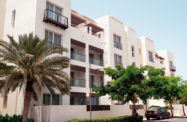After posting robust growth in 2015, Oman’s real estate sector has seen prices decline early this year, though sales remain strong in certain segments of the market.
According to data issued by the National Centre for Statistics and Information in May, the value of real estate transactions fell by 30.3% year-on-year (y-o-y) in the first quarter to OR922.1bn ($2.4bn).
This came on the back of high growth last year, with the total value of real estate activity expanding by 43.7% in 2015 to OR4.14bn ($10.8bn).
A similar trend was observed in the mortgage market. While the overall value of traded mortgage contracts dipped by 40% y-o-y in the first quarter to OR619.1m ($1.6bn), the number of new mortgages rose by 31.5% to 6969. This could suggest buyers’ cashing in on lower property prices in some districts.
Affected segments
In terms of the different property segments there has been varied performance, with the oversupply of retail space triggering a rise in the number of vacant units and a corresponding fall in rental returns in some older shopping centres.
However, higher-end residential units are still in demand, according to Benjamin Cullum, general manager of property services firm Hamptons International in Oman.
“There is still appetite for relevant real estate projects in Oman,” he told OBG. “A developer that anticipates market demand can do very well here.”
Though international property consultancy Cluttons expects residential rental rates to continue to ease by 5-10% over the rest of the year, after falling by 12.7% y-o-y in the first three months, it also noted the investment upside of a cooling market.
In its most recent assessment of the Omani real estate sector, released late in the second quarter, Cluttons said that vacancy rates in second-tier properties would likely increase, but that this would allow landlords to take a longer-term position and upgrade and refurbish rental stocks.
An easing of demand in some segments could also benefit potential buyers and renters, allowing them greater choice in the market, though Cluttons said correctly priced quality properties were still moving quickly.
Dharmendra Sharma, CEO of Al Arkan Construction, also sees demand and returns on newer residential stock remaining steady.
“Rent has gone down in old residential buildings, but new projects with full amenities are not reducing rental prices,” he told OBG. “People are not worried about spending on real estate and other amenities, even though oil prices are down.”
High exposure offset by banking stability
As prices in Oman’s real estate sector continue to recalibrate from the bull market of 2015, stakeholders will continue to monitor the health of the country’s banking sector, which has substantial direct and indirect exposure to the real estate sector, according to the latest financial stability report from the Central Bank of Oman (CBO), released in July.
“The total real estate exposure of the banking sector is over 30% of total lending portfolio, which is considered large,” the report noted. “A weakening real estate market could, therefore, expose the banking sector to considerable risks.”
This exposure also extends to Oman’s sharia-compliant financial sector, with the CBO saying the high level of real estate lending by Islamic banks warranted a review of the segment’s credit policies and practices.
Banks should develop a strategy to further diversify their portfolios away from a dependence on real estate so as to protect themselves against any asset shocks in the property market, the CBO said.
While the central bank urged caution, it also stressed the underlying strength of the financial sector, characterising solvency levels as robust.
Additionally, quantitative ceilings placed by the CBO on mortgage lending – including an 80% loan-to-value ratio and a 50% cap on total lending to households – are expected to help prevent the formation of asset price bubbles.
Oxford Business Group is now on Instagram. Follow us here for news and stunning imagery from the more than 30 markets we cover.

